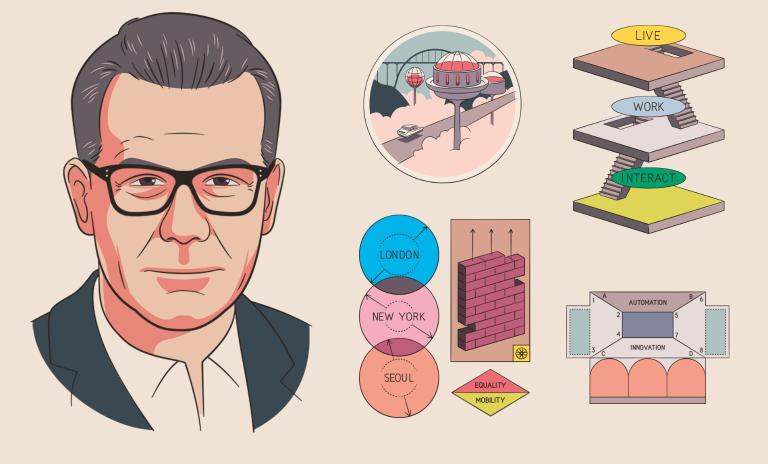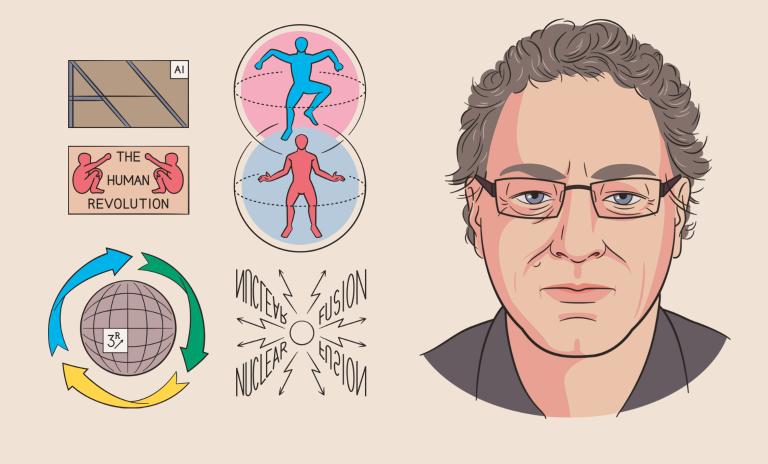Journey to the future
![{[downloads[language].preview]}](https://www.rolandberger.com/publications/publication_image/ta39_en_covers_1_final_download_preview.jpg)
What if we could journey to the future to gain insights for 2050 and beyond? Think:Act gives you a playbook for the future to adapt, survive and thrive.


by Geoff Poulton
Illustrations by Jacques Kleynhans
Predicting the future is no longer the preserve of fortunetellers. Some experts can read the data as to what we can expect in the future – with some thoughts on how to prepare for the changes. We talk to three subject specialists to find out how we might experience the world in the coming decades and beyond.
At the beginning of the 20th century, writer H.G. Wells’ predictions for 2000 got plenty of things right: suburban growth, the European Union, space travel and satellite TV. He also got a few things wrong: Submarines would fail and capitalism would collapse amid a series of chaotic wars. Today, Wells' work is widely considered to be the birth of futurology – the study of social, technological and environmental trends to anticipate life in the future.
There are now thousands of futurists around the world, scouring data, observing trends and tapping into their imaginations to deliver forecasts to businesses, governments and the general public. Here, we cast our gaze forward a few decades and consult three experts on their expectations for a few of the most important changes, all of which will have a profound impact on how we live and work.
Some people think cities are going to change massively over the next couple of decades – I don’t think this will be the case. Sure, in 2040, there'll be some lovely new buildings, robot deliveries, a few drones flying overhead and more automated vehicles on the streets. But cities will, for the most part, look and feel the same as they do today. The “Jetsons future” is still a long way off. What cities will be are more efficient places to organize human activity. That means better mobility and improved space utilization with more multiuse facilities, also thanks to remote work technology.
The days of the central business district (CBD) devoted to packing and stacking knowledge workers who commute in every day are over. CBDs are going to become more like CCDs – central connectivity districts. So we’ll have different kinds of workspaces devoted more to interaction. They’ll become more 24/7, with living as well as working areas. And because the likes of London and New York are the best places in the world to connect – in terms of flight connections, airport infrastructure, hotels, restaurants and so on – they’ll still be just as important, if not more so.
"It’s going to be a difficult adjustment period. And we’re going to have to change things."
While there’s been much debate about the death of major, superstar cities, I think they’ll actually get bigger, not smaller. And I’m not just talking about physical agglomeration and spreading out – there will also be more virtual agglomeration. We’re going to see bigger networks of cities with the major urban areas at their hub. Cities will be physical and digital at the same time. If we take London as an example: Other cities in the UK will physically become part of a more London-anchored complex, but London also has increasingly strong virtual connections to cities and outposts around the world. And that means we’re going to get digital suburbs. So, the center point of someone’s work may be London, and they may have to commute there once a quarter, but they live somewhere completely different. In the US, we’re seeing Miami emerge as a digital suburb of New York, for instance.
Demographics and social mobility will also be hugely important for the development of cities over the next couple of decades. Economic mobility will require geographic mobility – the talented, educated and ambitious people will move more than ever before to look for opportunity, particularly the younger generation. This will make big cities even more cosmopolitan. They are the talent magnets for the world – that won’t change. And because of communication and remote work technology, many more people no longer need to stay in these cities long term to continue to reap the benefits.
Of course, it’s vital we consider those who don’t have this mobility. We need to create a new social compact that gives people opportunity and enables them to lead purposeful lives. I have no doubt that we’ll work it out, but it will take time. The great thing about cities is that they are so diverse. Solutions to these sorts of problems typically arise in cities before being rolled out at a national level.
Make no mistake: It’s going to be a difficult adjustment period before we get there. And we’re going to have to change things. We need to create more effective toolkits for building better cities – particularly in the developing world, which is entering its main period of urbanization. The institutions and frameworks that support leadership and policy direction at the national level don’t exist for mayors and local officials. And we’re moving far too slowly. Poverty, inequity, climate change – the great challenges of the world are nested in cities. But our cities and city leaderships don’t have the tools and the capabilities they need to solve these problems they face. They need more autonomy if we are to build better cities around the world.
The next 20 years will bring more change to humanity than the previous 200 as the exponential curves for a number of technologies really take off. We’ll go from 3D-printing small, simple things like dental implants to rapidly creating complex, vital objects such as houses, body organs and food, for example. Quantum computing will help deliver unlimited clean energy via nuclear fusion. And we’ll have outsourced most of our dull, repetitive and dangerous work to machines. In fact, by 2040, many of us may only need to work just three or four hours a day.
Which is not to say that machines will have taken over completely. Humans will have more freedom to focus on other, more creative kinds of work. People have many kinds of intelligence – emotional, social, kinesthetic and so on. Machines only really have one – logic. While they are already much better than humans in this area – a gap that will continue to grow wider – we will remain ahead of machines in many other aspects for a few decades yet. Until the singularity, at least. But that’s another story.
When it comes to the world of work, we need to be mindful of who benefits from the huge jumps in efficiency and productivity that AI and robotics will bring. The financial gains must be distributed fairly. This is something both the private and public sectors need to figure out in the relatively near future. Policymakers can’t just ignore the externalities of automation.
Because the pace of change is accelerating so quickly, governments are really going to have to shape up and get future-ready. They need to know what’s coming. Most of them are still too fixated on the past or the next election cycle – this will have to change. While we don’t want to inhibit the development of science and technology, we do need to ensure that it is controllable and to our benefit.
One crucial area that technology will improve tremendously over the next 15-20 years is health care, which is still extremely expensive and inefficient. But in 2040, most of us will have personal devices that constantly record all sorts of health-related data – weight, blood sugar, heart rate and so on. AI systems will be able to analyze this data and provide tailored recommendations for ways we can improve our health – food, drugs, exercise. This will help us to massively reduce the prevalence of diseases like diabetes. Instead of “sick care,” we’ll have real, proactive health care. But, just like with the workplace, we’ll need a supervised public mechanism to make sure this is done safely and securely.
I think we’re going to see three revolutions: the digital revolution is ongoing; the sustainability revolution is just beginning; and we’ll also have the human revolution. People are sick and tired of hearing that machines will take over and that we’re heading toward a dystopian future. We’re going to realize that we need rules, regulations and social contracts that ensure we respect humanity. And we’re going to realize that we need to work together to create what I call “the good future.” Because we’re not short of solutions or money; we’re just short of collaboration.
"Marketing will feel more like a friend telling you about a product they know you will love before you realize you need it."
Shopping will become much more about the experience than the products people buy. That’s because the shopping experience of the future will be more personalized and technology-driven, able to move seamlessly between the physical and digital worlds to give customers exactly what they want when they want it. Stores will become experimental showrooms where customers can connect with brands in new ways, rather than to purchase items. They want to touch products, see how they work and then have them personalized and delivered quickly to their homes. Physical stores will leverage technology to create unique customer experiences, such as using augmented reality (AR) or virtual reality (VR) to showcase the product. It will be the best of both worlds: a customized product with quick and convenient delivery, while also providing the human touch of personalized service and a memorable experience. People aren't going to suddenly disappear from the shopping experience – brands have to strike a balance between innovation and the human element.
Personalization also extends to sales as well as marketing. In 10-15 years’ time, customers will be much more aware of companies’ techniques to get their attention and try to sell them things. The future of sales and marketing is extremely targeted so that customers feel like they are being recommended products and experiences they don’t yet know they need instead of constantly being pushed to buy the same items as everyone else. Marketing will feel more like a good friend telling you about a product they know you will love and use before you realize you need it, rather than constantly being yelled at to buy the newest product. And with that in mind, companies will need to tone down their mass-marketing efforts and focus on data and personalized outreach. They need to understand their customers completely and translate that understanding into a unique experience almost instantly.
I expect customers to gain even more power over the next couple of decades. They won’t choose a brand simply on product or price – it will be about the entire experience, especially around what the brand stands for and the good the company does in the world. If a brand isn’t transparent or authentic and doesn’t take a stand on important issues, customers won’t want to use it. Sustainability and community involvement will be much more important – something that companies still underestimate today. In the future, customers are more likely to connect with brands that take a stand and make a difference in the world – and they will stay incredibly loyal to those brands.
Ultimately, customers trust companies to make a difference in the world more than they trust governments. Brands have an incredible responsibility – and opportunity – to change the world through sustainable efforts, getting involved in their communities and standing up and raising awareness for critical social issues. Brands that don’t showcase authenticity and transparency will be overlooked by customers and become obsolete.
While the world seems especially full of uncertainty and unpredictability right now, it’s worth remembering that this is nothing new – societies have evolved for thousands of years. What is different about today is the pace of evolution, driven mostly by technological innovation. Industries, supply chains and much of the global population are more connected than ever, ensuring the ripples of change quickly spread far and wide. Of course, this has brought – and will continue to bring – huge benefits to much of the world, from improved health care and sanitation to better mobility and communication. But are we reaching a tipping point? While each of our three experts focus on very different areas of society, a common thread is the importance of human experience and connection; in creating our future, we must remember that technology should make us better, healthier, happier people, not just more efficient ones.
Viewed through today’s lens, this seems like a positive, logical goal. But, of course, values, perceptions and priorities can – and likely will – change. As Chuck Klosterman reminds us in his book, But What If We're Wrong?, what once seemed reasonable can become absurd, from cultural tastes to scientific “laws,” which makes predicting the future decades from now almost impossible: “When you’re gazing into the haze of a distant tomorrow, everything is an assumption.”
![{[downloads[language].preview]}](https://www.rolandberger.com/publications/publication_image/ta39_en_covers_1_final_download_preview.jpg)
What if we could journey to the future to gain insights for 2050 and beyond? Think:Act gives you a playbook for the future to adapt, survive and thrive.





